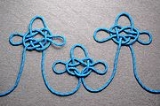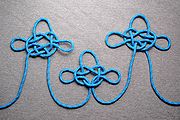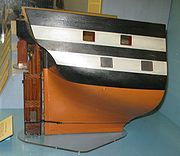
Jury rig
Encyclopedia
Jury rigging refers to makeshift repairs or temporary contrivances, made with only the tools and materials that happen to be on hand. Originally a nautical term, on sailing ship
s a jury rig is a replacement mast
and yards improvised in case of damage or loss of the original mast.
's A Description of New England. It appeared again, in a similar passage, in Smith's more extensive The General History of Virginia, New-England, and the Summer Isles published in 1624.
There are several theories about the origin of this usage of "jury":
 While ships typically carried a number of spare parts (e.g., items such as topmast
While ships typically carried a number of spare parts (e.g., items such as topmast
s), the lower masts, at up to one meter in diameter, were too large to carry spares. So a jury mast could be various things. Ships always carried a variety of spare sail
s, so rigging
the jury mast once erected was mostly a matter of selecting appropriate size. Contemporary drawings and paintings show a wide variety of jury rigs, attesting to the creativity of sailors faced with the need to save their ships. Example jury-rig configurations are:
The Jury mast knot
is often mentioned as a method to provide the anchor points for securing makeshift stays
and shrouds
to the new mast. However, there is a lack of hard evidence regarding the knot's actual historical use.
Although ships were observed to perform reasonably well under jury rig, the rig was quite a bit weaker than the original, and the ship's first priority was normally to steer for the nearest friendly port and get replacement masts.
Another source of this term comes from World War Two; in this case, a pun-like play on words. Advancing Allied forces plundering abandoned German bases found a use for emptied metal gasoline cans, nicknamed "Jerry Cans" after the slang term for German. Engineers and mechanics, enduring major supply shortages to the front lines, would jerry-rig the metal from the canisters for use in repairing a damaged hull, fuselage, or any easily fabricated equipment part.

Sailing ship
The term sailing ship is now used to refer to any large wind-powered vessel. In technical terms, a ship was a sailing vessel with a specific rig of at least three masts, square rigged on all of them, making the sailing adjective redundant. In popular usage "ship" became associated with all large...
s a jury rig is a replacement mast
Mast (sailing)
The mast of a sailing vessel is a tall, vertical, or near vertical, spar, or arrangement of spars, which supports the sails. Large ships have several masts, with the size and configuration depending on the style of ship...
and yards improvised in case of damage or loss of the original mast.
Etymology
The phrase "jury rigged" has been in use since at least 1788. However, the adjectival use of "jury" in the sense of makeshift or temporary dates from at least 1616, when it appeared in John SmithJohn Smith of Jamestown
Captain John Smith Admiral of New England was an English soldier, explorer, and author. He was knighted for his services to Sigismund Bathory, Prince of Transylvania and friend Mózes Székely...
's A Description of New England. It appeared again, in a similar passage, in Smith's more extensive The General History of Virginia, New-England, and the Summer Isles published in 1624.
There are several theories about the origin of this usage of "jury":
- From the LatinLatinLatin is an Italic language originally spoken in Latium and Ancient Rome. It, along with most European languages, is a descendant of the ancient Proto-Indo-European language. Although it is considered a dead language, a number of scholars and members of the Christian clergy speak it fluently, and...
adjutare ("to aid") via Old FrenchOld FrenchOld French was the Romance dialect continuum spoken in territories that span roughly the northern half of modern France and parts of modern Belgium and Switzerland from the 9th century to the 14th century...
ajurie ("help or relief"). - A corruption of joury mast—i.e. a mast for the day, a temporary mast, being a spare used for the nonce when the mast has been carried away. (French, jour, a day.)
- Contraction in the nautical tradition for injury
Rigging

Topmast
The masts of traditional sailing ships were not single spars, but were constructed of separate sections or masts, each with its own rigging. The topmast is one of these.The topmast is semi-permanently attached to the upper front of the lower mast, at the top...
s), the lower masts, at up to one meter in diameter, were too large to carry spares. So a jury mast could be various things. Ships always carried a variety of spare sail
Sail
A sail is any type of surface intended to move a vessel, vehicle or rotor by being placed in a wind—in essence a propulsion wing. Sails are used in sailing.-History of sails:...
s, so rigging
Rigging
Rigging is the apparatus through which the force of the wind is used to propel sailboats and sailing ships forward. This includes masts, yards, sails, and cordage.-Terms and classifications:...
the jury mast once erected was mostly a matter of selecting appropriate size. Contemporary drawings and paintings show a wide variety of jury rigs, attesting to the creativity of sailors faced with the need to save their ships. Example jury-rig configurations are:
- A spare topmast
- The main boom of a brigBrigA brig is a sailing vessel with two square-rigged masts. During the Age of Sail, brigs were seen as fast and manoeuvrable and were used as both naval warships and merchant vessels. They were especially popular in the 18th and early 19th centuries...
- To replace the foremast with the mizzenmast: mentioned in W. Brady's The Kedge Anchor (1852)
- The bowspritBowspritThe bowsprit of a sailing vessel is a pole extending forward from the vessel's prow. It provides an anchor point for the forestay, allowing the fore-mast to be stepped farther forward on the hull.-Origin:...
set upright and tied to the stump of the original mast.
The Jury mast knot
Jury mast knot
The Jury mast knot is traditionally used for jury rigging a temporary mast on a sailboat or ship after the original one has been lost. The knot is placed at the top of a new mast with the mast projecting through the center of the knot. The loops of the knot are then used as anchor points for...
is often mentioned as a method to provide the anchor points for securing makeshift stays
Stays (nautical)
Stays are the heavy ropes, wires, or rods on sailing vessels that run from the masts to the hull, usually fore-and-aft along the centerline of the vessel...
and shrouds
Shroud (sailing)
On a sailboat, the shrouds are pieces of standing rigging which hold the mast up from side to side. There is frequently more than one shroud on each side of the boat....
to the new mast. However, there is a lack of hard evidence regarding the knot's actual historical use.
Although ships were observed to perform reasonably well under jury rig, the rig was quite a bit weaker than the original, and the ship's first priority was normally to steer for the nearest friendly port and get replacement masts.
Another source of this term comes from World War Two; in this case, a pun-like play on words. Advancing Allied forces plundering abandoned German bases found a use for emptied metal gasoline cans, nicknamed "Jerry Cans" after the slang term for German. Engineers and mechanics, enduring major supply shortages to the front lines, would jerry-rig the metal from the canisters for use in repairing a damaged hull, fuselage, or any easily fabricated equipment part.
Similar phrases

- A false etymologyFalse etymologyFolk etymology is change in a word or phrase over time resulting from the replacement of an unfamiliar form by a more familiar one. Unanalyzable borrowings from foreign languages, like asparagus, or old compounds such as samblind which have lost their iconic motivation are...
is that "Jerry-rigged" was employed by World War II British troops to refer to the German use of scavenged parts to keep vehicles and weapons functional, from the use of "Jerry" as a pejorative term for German soldiers. - The phrase "jerry-built" has a separate origin and implies shoddy workmanship not necessarily of a temporary nature.
- "Jiggered" is derived from "jerry-rigged". Although this has come into more common usage, it is still a pejorative term used to denote a poor quality short-lasting fix.
- To "MacGyverMacGyverMacGyver is an American action-adventure television series created by Lee David Zlotoff. Henry Winkler and John Rich were the executive producers. The show ran for seven seasons on ABC in the United States and various other networks abroad from 1985 to 1992. The series was filmed in Los Angeles...
" something is to rig up something in a hurry to make an item work, from the U.S. television show of the same name and its title character, who would often use such homemade rigs.

